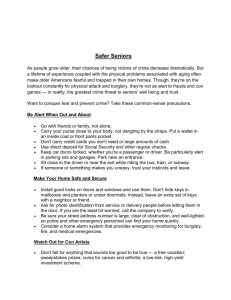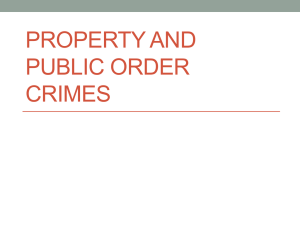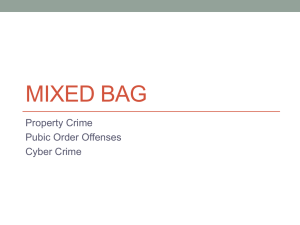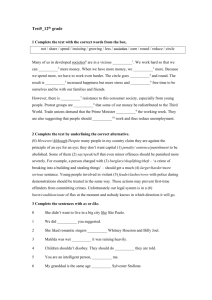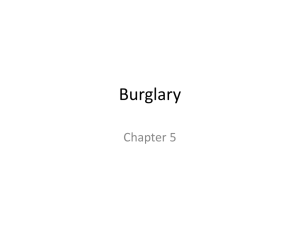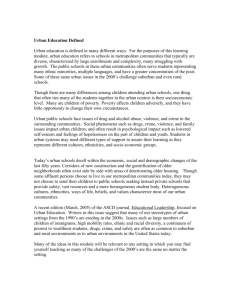Welcome Back
advertisement
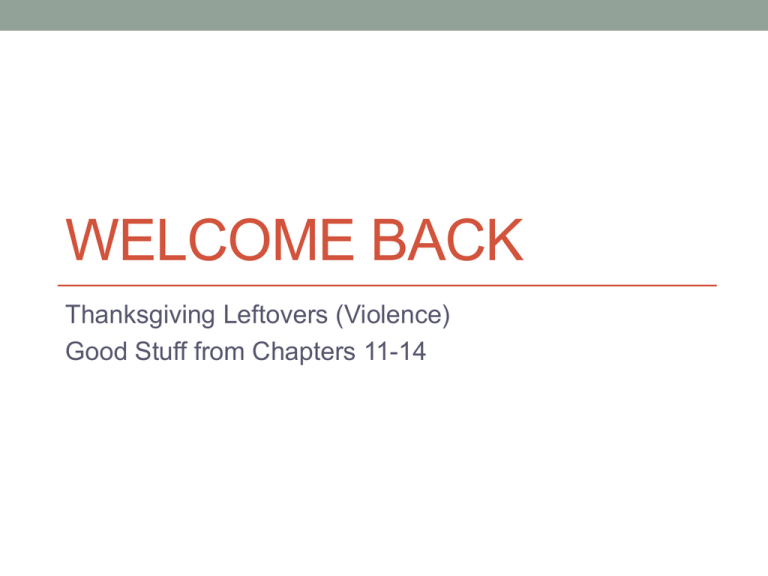
WELCOME BACK Thanksgiving Leftovers (Violence) Good Stuff from Chapters 11-14 General Explanations for Violent Crime 1. Neighborhood level explanation of violence 2. Individual level explanations of violence 3. Gender and violence Neighborhood Level Explanation of Violence Violent crime more likely to occur in urban areas characterized by ▪ ▪ ▪ ▪ ▪ Extreme poverty Physical decay Residential mobility Social disorganization theory ▪ ▪ Weak/absent neighborhood institutions and processes little informal control Cultural transmission of deviant values Individual Level Explanations of Violence ▪ Social Learning Theory as Example ▪ Violence is learned ▪ ▪ ▪ ▪ ▪ Operant conditioning Vicarious learning Mass media influence? Intimate personal groups = peers, siblings, parents Intergenerational transmission of violence Gender and Violence ▪ Biological differences ▪ ▪ ▪ Physical Physiological Masculine sex-role socialization ▪ ▪ ▪ ▪ Competitiveness Aggressiveness Lack of emotionality Conducive to violence Explaining the Violence Drop ▪ “Usual Suspects” ▪ ▪ ▪ ▪ ▪ ▪ Police tactics Increase in prison populations Economic conditions Changes in demographics Cultural shift Role of illicit drugs Property Crimes • Burglary • Arson • Larceny-Theft • Motor Vehicle Theft Burglary • Unlawful entry into building/dwelling • Intent to commit a crime (usually theft) • AKA, “Breaking and Entering” or B&E • Nature and Extent • Residential burglary has been on the decline since we’ve had the NCVS (stable over past decade) • 26/1,000 or 2.6% of households • 61% of B&E’s involve forceful entry • Arrestees as male (84%), white (67%) • Low income, rental hosing more prone to burglary Research on Burglars/Burglary • Professional vs. Amateur • Some truth to media stereotype of professional burglars • Network of fences, information, etc. • Learning process (older friends, family members, street associates) • Amateur = opportunity x need Theories & Burglary • Rational Choice Theory • Especially for “criminal event” • Target selection, evading law enforcement, etc. • Other theories predict criminal involvement (why burglary and not a job?) • Social learning • Low self-control • Pretty much all theories Burglary vs. Robbery • Robbery = use or threat of force • Upside = steal cash to use immediately • Burglary • Need “fence” or some way to sell stolen items • Newer trend = Craig's list, ebay, etc. • May be more “planned” (sometimes) Response to Burglary • Very low clearance rate (10-15%) • That includes multiple crimes from single offender • Situational Crime prevention • Shrubbery maintenance , burglar alarms, dog, sign that says you have dog or alarm, good locks, timer lights Arson • Willful or malicious burning or attempting to burn, with or without intent to defraud, a dwelling house ,public building… • Not in NCVS • UCR 63,000 arsons reported to police in 2008 • Almost half of those arrested were juveniles • 84% males, 76% white • Low (18%) clearance rates • Fire starters/pyromaniacs vs. “hired torch” Larceny-Theft • The completed or attempted theft of property or cash without personal contact • Shoplifting, purse snatching, theft of motor vehicle parts… • Not burglary (no breaking in) or robbery (no use or threat of force) • Types • Grand Larceny (> than x$) vs. Petit Nature/Extent of Larceny-Theft • NCVS vs. UCR • NCVS only personal (not business) so estimates differ • Most common form of property crime • 67% of all property crime known to police • Heavily underreported (34% reported) • Average value of reported theft about $1,000 Explaining/Controlling Theft • With some exceptions, not a lot the CJS can do (low clearance) • Exceptions = stings, data-driven surveillance • Lots of advances in target hardening and guardianship in private sphere • Credit cards? Theft by check? Shoplifting? • Great variation in motivation for theft • Support drug habit, thrill, hedonism, professional… Motor Vehicle Theft • Theft or attempted theft of car, RV, boat, etc. • Cincinnati attempted theft of canoe • High reporting to police • Highest recovery rate of all stolen property • Typology • Joyriders, professionals /profit, use , fraud • Fence for autos = “chop shop” • What type of care is most likely to be stolen? Public Order Offenses • “Blue Laws” • Prostitution • Gambling • Drug use / sale • Public intoxication / urination / defecation • Disorderly conduct • Panhandling • Fornication, adultery, sodomy, bestiality Fodder for much discussion… • Conflict perspective &labeling theory • Consensus over laws + enforcement • Use of the criminal justice system (especially police) • Discrimination based on race, place, and class • Discretion increases as crime seriousness decreases The “enforcement” camps • Morality / Harm perspective • Harmful or morally reprehensive behaviors should be illegal • Moral entrepreneurs + conflict theory • May or may not be based on empirical facts • Law and Order Perspective • Broken windows /order maintenance , routine activities, and social disorganization • Tolerating the little stuff” breeds crime and interferes with neighborhood collective efficacy The “back up the truck, chuck” view • Reasons to be skeptical about enforcement • Restricting goods/services drives up profit • Organized crime thrives on black markets • Driving up the cost of products leads to users engaging in crime to get money for product/service • Takes enforcement time/resources away from more serious forms of crime • Problems related to police enforcement • Police corruption • Police violation of procedural law • Race/class/place discrimination (high discretion) • Relates also to the “Libertarian” Ideology The case of Alcohol • How did prohibition come about? • Moral entrepreneurs (moral perspective) • Temperance Movement, “Abstinence Societies” • Ethnic/religious conflict (Upper/middle class vs. working class; protestant vs. others) • 18th Amendment (1920) and Volstead Act • Why was prohibition repealed? • Harm of substance versus harm of prohibiting • Unintended consequences outweighed positive effects Prostitution • Estimates of “use” rates vary widely • 3% (GSS) to 20% (Janus2) • Difficult to estimate number of active prostitutes • Underrepresented on any “lists” to be sampled • Estimates from 50,000 to 4.2 million • FBI data on arrests reflects policy/policing Prostitute Hierarchy • Crack Prostitutes • Trade sex for drugs and/or cash • Street-walkers • Classic media version • Overrepresented in research and arrests • Call girls / brothels / massage parlors • Better working conditions (choice of clients, hours, etc) • Critics: categories not exclusive, more similar (risk of violence, etc.) than different Prostitution • Morality view • Prostitutes as victims, coerced into prostitution • High rates of sexual abuse, drug abuse, etc • Coercion and patriarchy • Law and Order view • Public prostitution creates fear/disorder, prostitutes and “johns” as targets for other crimes • Back up The Truck (BUTT) view • Sex sales similar to alcohol/drugs/gambling • “Streetwalkers” vs. “Call-girls” controversy • Moralists = not very different (path into, daily life as prostitute) • Skeptics = many streetwalking problems as result of illegality Gambling • Trend toward legalization • Riverboats, Native American casinos, race tracks, “racinos” • Moralists • Problem gamblers, affects family/friends, etc. People commit crime to get gambling money or hide debt • Law and Order • Controlled by organized crime, invites other sort of criminals • BUTT • Most people who gamble are not problem gamblers, use heavy taxation for public good • Or in the case of MN, to house the sporting “bad” Should we strictly enforce public order laws? • Broken Windows review • Little stuff (public disorder) breeds serous crime • Sends message that nobody cares • Creates perception of neighborhood being unsafe • Reduces collective efficacy • Examples = Times Square, squeegee men, pan handling, use of “foot patrols” • Downside of “order maintenance” policing? • Middle ground between zero tolerance and no enforcement? • Kennedy’s focused deterrence • “De-penalization” (prostitution)
